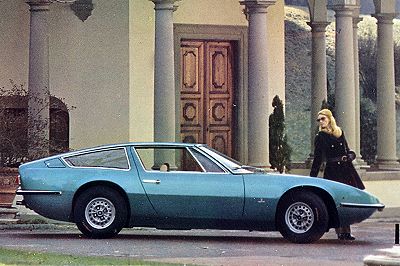| The Indy
"Indy... to celebrate Maserati's two victories in the 500 mile classic." |
 |
||
|
|
|||
|
|
|||
|
In 1968, at the Salone dell'Automobile di Torino, there appeared on the Carrozzeria Vignale stand the prototype of a sleek new four-seater coupé, based on Maserati's now established V8 front-engined rear wheel drive format. |
 |
In March 1969, at the Salone d'Automobile de Genève, Maserati launched the Maserati Indy, named to commemorate Maserati's great victories in the 500 mile race at Indianapolis in 1939 and 1940. Maserati are still the only Italian Marque, along with Dallara, to have won this famous race! The Indy was favourably received by both the press, public and fans of Maserati's fabulous GTs. |
Transmission was by way of a ZF 5-speed gearbox (a 3-speed Borg-Warner automatic gearbox was available as an option). Front suspension was independent with double wishbones, coil springs and an anti-roll bar while at the rear there was a live axle on leaf springs located by a single torque reaction arm restrained by another anti-roll bar. The dual circuit braking system, with four ventilated disc brakes, was servo assisted. Power assisted steering and a limited-slip differential were also available on request. |
|||
Vingale's design concealed an ample interior where even the rear passengers were afforded plenty of room. The luggage area, accessed via the almost horizontal hatch, was excellent with around 18 cubic feet of space. This area was flanked by two 50 litre petrol tanks, the battery, spare wheel, car jack and an adequate tool kit being housed under the boot floor. |
|||
The re-designed dashboard now had a three-spoked adjustable (up and down) Nardi steering wheel, behind which was a compact binnacle housing a speedometer, rev counter and oil pressure guage. Situated in the centre of the dash was a line of five guages angled towards the driver; an oil temperature guage, a water temperature guage, a fuel guage, an analogue clock and an amp meter. On the passenger side in place of the glove box was a full-width grab handle. The centre console accomodated the radio, heater cotrols and a row of rocker switches that included those for the electric windows. Further down the console was the customary ashtray and a lockable glove box. |
|||
Total production of the Indy between 1969 and 1975 consisted of 1,104 cars (440 4.2-litre cars, 364 4.7-litre cars and 300 4.9-litre cars). The Maserati Indy was one of the last in a long line of traditional front-engined rear wheel drive Maseratis powered by a classic, normally aspirated, four overhead camshaft, V8 engine, the last being the Khamsin. That is, until now! From Christian in The Netherlands: Thank you Christian. It's always nice to receive feedback. |
|||
| TECHNICAL DATA - TIPO 116 | |
| Body type | 2-door 4-seater Coupé |
| Production years | From 1969 to 1974 |
| Engine | Front engined V8 |
| Bore and stroke | 88 mm X 85 mm (from 1970 also 93.9 x 85 mm - from 1973 93.9 x 89 mm) |
| Engine capacity | 4136 cc (from 1970 also 4719 cc - from 1973 4930.6 cc) |
| Compression ratio | 8.5:1 |
| Maximum power | 260-bhp @ 5500 rpm (290 bhp @ 5500 rpm) |
| Distribution | Four overhead camshafts, two valves per cylinder |
| Induction system | Four twin choke 42 DCNF Weber carburettors |
| Ignition | Transistorised (from 1970 by Bosch) |
| Lubrification | Forced with pressure pump, total draining |
| Transmission | Rear wheel drive |
| Differential | Salisbury 'live' axle |
| Clutch | Dry single plate with flexible coupling and hydraulic control |
| Gearbox | 5 speed and reverse |
| Chassis | Integral body chassis construction |
| Front suspension:- | Independent wheels, coil-springs, telescopic shock-absorbers and anti-roll bar |
| Rear suspension:- | Live axle on leaf-springs with single torque reaction arms and anti-roll bar |
| Brakes | Servo assisted disc brakes on all four wheels |
| Wheelbase | 2600 mm |
| Wheel tracks | Front 1480 mm Rear 1434 mm |
| Tyres | Front and rear:- 205 x 14 (from 1973 205 x 15) |
| Dry weight | 1500 kg |
| Maximum speed | 250 - 265 km/h |
| Models constructed | 1104 |
 |
|
To enter Enrico's Maserati Pages CLICK HERE! Copyright: Enrico's Maserati Pages - © 2000-2004. All rights reserved. |































